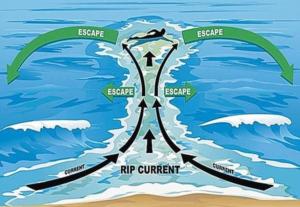The Costa Rica News (TCRN) – Costa Rica beaches are considered some of the most beautiful and pristine in the world, they are always dynamic and sometimes deadly.
A rip tide (rip current) is a frightening thought, and if you are caught in one you might not be aware of it till it’s too late. It is estimated that ninety percent of Costa Rica’s approximate 200 annual drowning deaths occur on about 30 of Costa Rica’s 600 plus beaches, and rip currents are to blame for 80% or more of these.
There are many factors contributing to ocean-related deaths, including weather, location (river and estuary mouths, shelf drops, natural structures, etc.), alcohol and misinformation, however the most deadly is the rip current.
Rip currents are caused by water being pushed up the beach above the average/mean sea level by large breaking waves. Swashes generated by plunging breakers of large swell waves are the most effective in creating the conditions for a rip current.
As in the normal swash process, this water that pushed up on the beach gets pulled back down the slope to the sea surface. The subsequent large breaking waves continue to pile the water up on the beach, causing a temporary build up or damming effect. Water then follows the path of least resistance to the lowest level, such as following an underwater trough. This concentrated flow of returning water to the ocean becomes a rip current, moving rapidly away from the beach toward the offshore.
Essentially it is a current that acts like a fast river flowing away from shore at speeds up to 7.5 mph which is faster than the fastest swimmers in the world.

The three components of a rip current are the feeder current, the neck, and the head. The feeder current runs parallel to the beach and is the source of the outgoing water. You know you are in a feeder current when you notice you are moving swiftly parallel to the shore. You can quickly find yourself hundreds of feet down shore in less than a minute.
You can feel when you are caught in the “neck” of the back channel out to sea even if you in only up to your knees. This kind of “pull” will feel stronger than just ordinary back wash of a wave. In a strong pull of a “neck” walk parallel to the beach, and move forward towards the beach allowing each wave to help push you to shore. Turning sideways as the waves helps you to keep your balance.
If you are in a “neck” and can’t touch bottom, do not attempt to swim against the current, you won’t be able to and it will drain your energy. Swimming parallel to the beach or floating it out are the only two options. The pull generally ends just past the break however; outflows have been known to go much further, the key is remaining calm.
Know What You are Looking For
Dirty water flowing away, like a river from the shore is a sign of a rip current. Often you can spot the feeder currents as a section of muddy water, sometimes foamy, moving parallel to shore. Rough surf often produces foam along the neck and head.
A calm area in the breaking wave may also indicate a rip current. River estuaries are dangerous areas, the outflow of the river mouth can form an extremely fast moving and deeper channel.
If you are visiting and beach that is not known to you, ask locals about rip conditions. Surfers and lifeguards are the most knowledgeable on rip currents. Also use your observation skills before running headlong into the surf.
It’s easy to assume the waters are safe especially when there are many people in the water, but doesn’t necessarily mean that the area is actually safe.
Types of Rip Currents
Fixed or Permanent Rips: A fixed rip is typically found near manmade structures that alter the natural wave formations. Fixed or permanent rips can also be formed by natural structures, sometimes hidden below the surface, such a rock formation. They are also around river mouths and estuaries.
Flash Rip: A flash rip generally does not last long, and are formed from natural wave conditions.
Traveling Rip: A traveling rip is formed on long, open beaches and usually travels with the wave direction.
Costa Rica beaches see millions of visitors each year and many have best beach awards, but the dangers of ocean are often masked by it beauty and splendor. Remember to research the beaches you are visiting in Costa Rica to ensure your visit is a safe one.
The Costa Rica News (TCRN)
San Jose, Costa Rica
